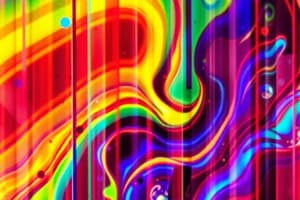Podcast
Questions and Answers
What is the prominent characteristic of a crystal, as mentioned in the text?
What is the prominent characteristic of a crystal, as mentioned in the text?
- Amorphous structure
- Variable structure
- Fixed structure (correct)
- Liquid structure
Who first observed the intermediate state between solid and liquid, leading to the concept of liquid crystals?
Who first observed the intermediate state between solid and liquid, leading to the concept of liquid crystals?
- An English biologist
- A German physicist
- An Austrian botanist (correct)
- An Italian chemist
What drives the technology of liquid crystal displays (LCDs)?
What drives the technology of liquid crystal displays (LCDs)?
- Gases
- Liquid crystals (correct)
- Amorphous materials
- Solid crystals
What happens when a solid is heated, according to the text?
What happens when a solid is heated, according to the text?
What did the Austrian botanist accidentally discover when heating a chemical during an experiment?
What did the Austrian botanist accidentally discover when heating a chemical during an experiment?
Study Notes
Crystals and Liquid Crystals
- Crystals exhibit a highly ordered, repeating arrangement of atoms, ions, or molecules, contributing to their distinct geometric shapes.
- The concept of liquid crystals was initially explored through the observation of an intermediate state between solid and liquid.
Historical Observations
- Frederick Reinitzer was the first to identify the intermediate state during his experiments with a specific chemical in the late 19th century, leading to the definition of liquid crystals.
Liquid Crystal Technology
- The operation of liquid crystal displays (LCDs) is driven by the unique properties of liquid crystals, which can change their arrangement in response to electric fields, thus controlling light passage and producing images.
Phase Changes of Matter
- When a solid is heated, it undergoes a phase change towards a more liquid state, during which the structured arrangement of its particles begins to break down.
Accidental Discoveries
- An accidental discovery by Austrian botanist Friedrich Reinitzer involved observing changes in a chemical's properties while heating, ultimately leading to insights about liquid crystals.
Studying That Suits You
Use AI to generate personalized quizzes and flashcards to suit your learning preferences.
Description
Learn about the fundamentals of liquid crystals, their importance in display technologies, and their role in driving LCDs. Explore the unique characteristics of liquid crystals and their significance in modern displays.




